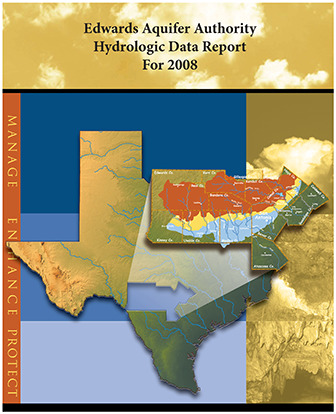Edwards Aquifer Authority Hydrologic Data Report for 2008

| Author | Hamilton M, Johnson S, Esquilin R, Burgoon C, Luevano G, Gregory D, Mireles J, Gloyd R and Schindel GM |
| Year | 2009 |
| Description | Annual report for 2008 on recharge, discharge, water levels and water quality in the Edwards Aquifer San Antonio Region |
| Report Number | 09-02 |
| Publisher | Edwards Aquifer Authority |
| Location | Edwards Aquifer - San Antonio Area |
| Cover | View Download |
| File | View Download |
| Summary |
|
This report presents the results of the Authority’s Edwards Aquifer Data Collection Program for calendar year 2008…. Water levels at the Bexar County (J-17) index well declined during the first six months of calendar year 2008, falling below the historical mean in June. The aquifer rose above the historical mean in July and maintained above-mean levels until November, when levels approximated the historical mean for the remainder of the year. Other wells in the region exhibited similar behavior. … Precipitation in the Edwards Aquifer region was below the mean in 2008….Total recharge to the Edwards Aquifer was significantly below median …In calendar year 2008, groundwater discharge from the Edwards Aquifer through wells and springs totaled 845,700 acre-feet. This amount is approximately 20 percent above the median of 705,600 acre-feet for the period of record (1934–2008). …Discharge from springs in 2008 was estimated to be 417,000 acre-feet, approximately 8 percent more than the period of record median of 321,100 acrefeet…. Springflow was higher early in the year and began to respond to continued drought conditions late in the year. … Detections of compounds for the samples collected were limited to one VOC, limited metals, nitrates below the MCL, and limited bacteria detections. …For well water samples collected in 2008, strontium was detected at one location in the freshwater part of the aquifer and at six locations in the saline zone above the 15,000 μg/L PCL. Other metals detected include iron at two locations above the secondary standard and manganese at one location above the secondary standard. Surface and spring water sample analyses did not indicate the presence of any regulated metals above a regulatory limit. Also for samples collected in 2008, raw groundwater bacteria results from wells ranged from less than two CFU/100 mL to five CFU/100 mL for fecal coliform, and from less than two to six CFU/100 mL for fecal streptococcus. …Of the 31 (total number of spring samples) samples, 11 were positive for fecal coliform, whereas 16 of 31 spring samples were positive for fecal streptococcus. In samples from wells, streams, and springs in the Edwards Aquifer region in 2008, nitrate-nitrite as nitrogen concentrations ranged from below the laboratory reporting limit of 0.015 mg/L to 7.88 mg/L. …Of the 31 total spring water samples collected, only one tested positive at a concentration above 2.0 mg/L for nitrates. … The compound tetrachloroethene was detected above the regulatory limit of 5.0 μg/L in one well in Uvalde County at 5.55 μg/L. The well is located within a historical PCE plume. No VOCs were detected in the spring samples nor in the one surface water sample collected for VOC analyses. … No SVOCs were detected in the 2008 sample set. …No sample tested positive for [herbicides, pesticides, and PCBs]. Edwards Aquifer water is generally of such high quality that it normally requires only chlorination to meet public drinking-water standards. However, detection of nitrates and organic compounds in the aquifer is a concern, and the Authority will continue to monitor for these compounds to determine possible sources and trends. Nitrate as nitrogen is a naturally occurring compound; however, concentrations above 2.0 mg/L may indicate anthropogenic impacts. … Confirmed detections of anthropogenic compounds such as PCE in Uvalde County are a concern and warrant continued monitoring in the future. The Authority’s aquifer-wide water-quality sampling program will continue to monitor wells, streams, and springs for indications of water-quality impacts throughout the region. Focused investigations of areas with water quality impacts will be initiated as needed. Continued drought conditions that began in the fall of 2007 resulted in declining water levels and springflows in the Edwards Aquifer throughout 2008. Springflows and water levels began the year at above-normal levels but finished the year below normal. The severity of the drought’s impact will be determined by the weather patterns for calendar year 2009. |
Search for Documents
Advance Search
Explore EAA's Scientific Reports
- All Reports
- Groundwater Recharge, Recharge Zone
- Groundwater Movement
- Geomorphology and Caves
- Weather Modification
- Geology
- Water Use and Conservation
- Geochemistry
- Water Resources Planning and Management
- Floods and Drought
- Water Quality
- Climatology
- Surface Water / Groundwater Relationship
- Biology
- Springs, Groundwater Discharge
- Archaeology
- RZ Protection
- Aquifer Levels
- Remote Sensing
- Precipitation
- Overview Studies
- Modeling
- Hydrology and Hydrogeology
- History
